All Dryers Are Customized
Engineers available to offer overseas service
All Year Round After Sale Hotline
Free Remote Technical Support and Train
Warranty: 1 Year
Certification: ISO9001
Application: Biomass, Corn Silage, Straw, Sawdust, Wood chips, Wood waste, Bamboo particles, Woodshavings, Cotton stalk, Mango seed, Rice husk
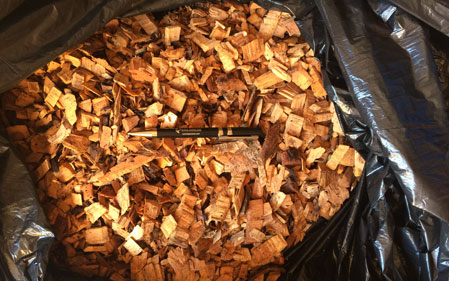
Before Drying
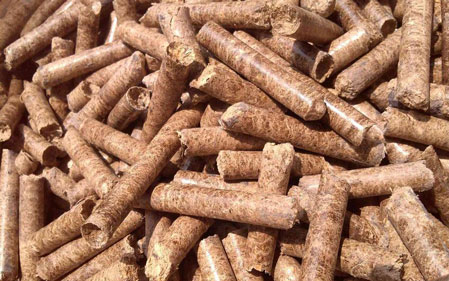
After Drying
Biomass, in particular fuel wood, is a predominant form of renewable energy in rural areas. The term biomass sources refer to forest resources, agro-residues, wastes, and municipal organic sewage, solid waste such as poultry and livestock dung. Biomass moisture content is exceptionally high, somewhere between 50 and 63%, based on the weather, climate, and nature of source. It is, therefore, necessary to dry the biomass to minimize the moisture content to an acceptable value of approximately 12–15% for further use. The characteristic calorific value of solid biomass is around 15–22 MJ/kg;
The use of biomass as power plant fuel is globally well accepted due to fossil fuel depletion and global warming. For instance, a lot of clients from the global market has plans to reduce the proportion of fossil fuel power plants and increase that of biomass power plants. Various types of biomass will be used as a fuel for power plants, including wood, grain, and municipal solid wastes;
Biomass as one of the cheapest alternative sources of heat, it is not only environmentally friendly but also offer benefits both in urban and rural areas for commercial purposes as they are much simpler compared with several other forms of dryers.
Thermal drying is a common method of moisture removal applied in industrial and agricultural processes. Drying is carried out for different purposes: to simplify and reduce the cost of biomass transportations, to increase the material strength, and to ensure easier processing. Drying is an essential technological activity to improve the quality of the product. It is, therefore, very crucial to identify the optimum design and use of the drying process.
Various drying processes are used to dry different products. The most common installations are those where convection drying with hot air or a mixture of air and exhaust gases as a drying medium takes place.
Rotary drum dryer is quite commonly used for the drying of biomass. There is single drum and three cylinder multiloop drum which rotates around 1 to 10 rpm around its axis. The drum is equipped with a sequence of external flights designed to raise, disperse the substance; the hot gas is supplied directly to the drum, which is mechanically turned by natural gas, biomass or coal etc. The energy loss to the product and the evaporation of the water vapour decreases the temperature of the gas. The speed of rotation, the flow rate, and temperature of the gas influence the removal of moisture from the substance.
Biomass fuel includes maize straw, sawdust, bamboo particles, wood shavings, shredded cotton stalk , shredded mango seed etc. The moisture is usually less than 50%, but very hard to dry, because the bound water content is relatively high.
ZJN dryer for biomass fuel with over 125 patent technology. Wet biomass Fuel enters first level of drying unit (inner cylinder) from feeding system. In this level, material trend is same with hot air flow. With the function of lifting boards, materials continuously been lifted and scattered and contact with hot air directly to realize heat transfer. Since the special line of guide boards, the general material trend is W type. In the second level (middle cylinder), material trend is opposite with hot air flow. Materials are constantly transferred forward and backward and lifted and scattered, thus being dried thoroughly. It extends the drying time and materials reach to the best drying state. In the third level (outer cylinder), the material and hot air trend same again. Wet materials transfer in multiple loops, higher-moisture materials go slowly, lower-moisture materials go faster. Therefore, the energy will be fully utilized and the drying more efficiently and evenly.
In the drying unit, hot air temperature and volume will be adjusted with fluctuations of water content. In the inner and middle cylinder, the temperature and air volume are relatively high. They are surrounded by the outer cylinder to form a self-insulation system. The heat dissipated on the inner and middle cylinder surface is involved in the material heat exchange, and the material in outer cylinder needs low temperature hot air, so the cylinder cooling area and heat loss significantly reduced. So our drying equipment can take full advantage of waste heat, reduce heat loss, increase the heat exchange area, thus effectively improving the heat utilization, reducing energy consumption, the equipment thermal efficiency is greatly increased.
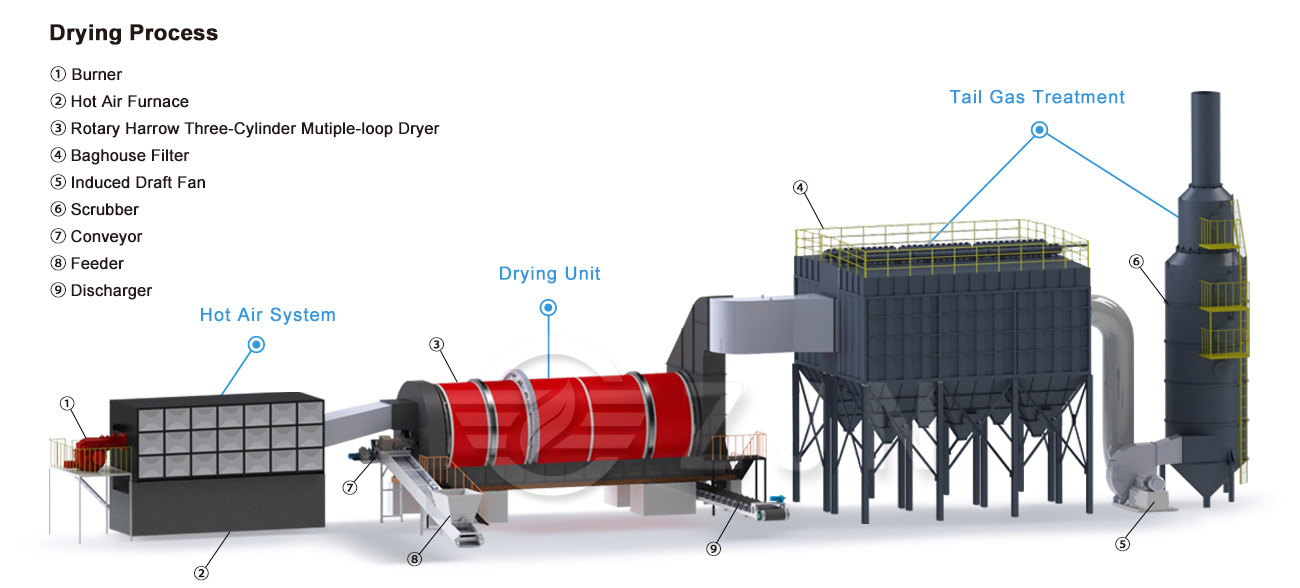
Biomass mainly includes the following categories:
1. Agricultural and forestry wastes, such as bark, wood chips, sawdust, bamboo chips, wood shavings, wood shavings, straw and other lignocellulose, as well as rice hulls, peanut hulls, edible fungus substrate, potato vines, bean stalks and so on.
2. livestock dung and other substances. Due to the high water content of these substances, combustion is not complete, so it needs to be dried to improve its use value. True energy saving biomass dryer is a new type of drying equipment developed by
ZJN environmental protection equipment Technology Co., Ltd. according to market demand. It is specialized for wood chips, sawdust, wood chips, bark, barley straw, sorghum straw, straw and other biomass materials drying and design. According to the drying demand, the equipment can choose "DC vortex and AC reciprocating" drying, "low temperature and large volume" drying technology, through the special cylinder structure, scientific and reasonable dispersing device and material lifting device, effectively improve the utilization rate of heat energy, speed up the drying speed. Because of the good quality, stable performance, simple control, and low price, the energy-saving biomass dryer has been recognized and praised by the majority of users.
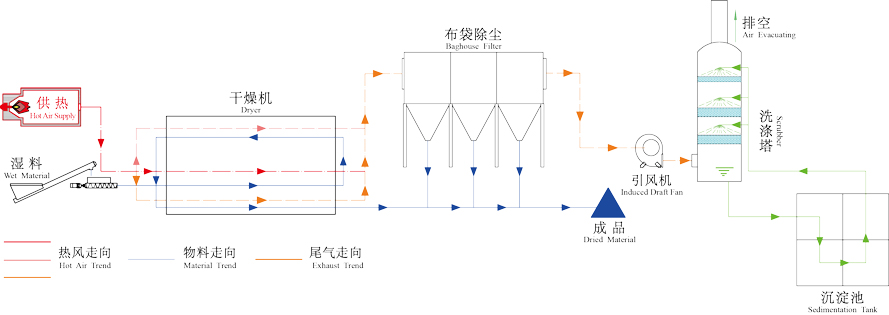
The whole workflow of the energy-saving biomass dryer can be divided into three drying stages. Namely downstream drying stage, counter-current drying stage, reciprocating drying stage.
1. Downstream drying stage. After the biomass material enters the dryer barrel, it is quickly scattered by the "rotary rake crushing" device to form fine particles. At the same time, it is constantly raised and thrown under the action of the material lifting system to strengthen the contact area with hot air and accelerate the heat and mass transfer effect. Wet biomass material and hot air move from the inner cylinder to the middle cylinder and the outer cylinder, and evaporates a large amount of water during the process.
2. Countercurrent drying stage. Hot air and biomass material reverse line, increase drying disorder, strengthen heat and mass transfer, this stage makes the material internal water seepage. And under the action of the push plate, into the next drying stage.
3. Reciprocating drying stage. "W + S" reciprocating biomass material technology, make the wet material reciprocating or slow, dry the biomass fast and first, after reaching the drying requirements, the finished product automatically discharged from the discharge port.
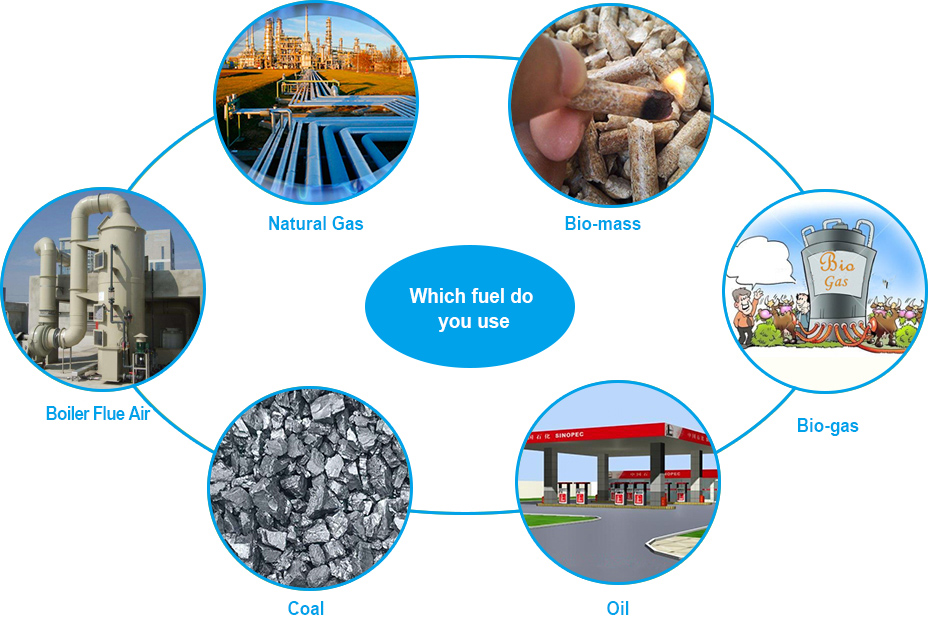
We have different hot air generating device for you. According to your Heat Source, no matter it is natural gas, bio-gas, coal, oil, bio-mass fuel or others, we match furnace, chamber, burner etc to be most suitable. What's more, the boiler flue gas can also be used as heat.
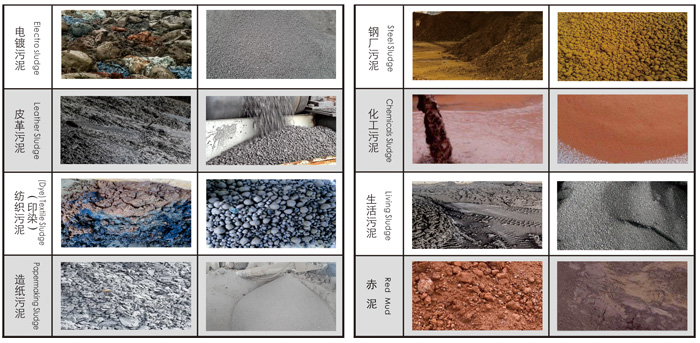
Biomass dryer is suitable for bark, sawdust, bamboo chips, wooden chips, shavings, straw, straw, potato vines, bean stalks, rice husks, peanut shells, animal feces, dregs and other materials drying. It can be widely used in agriculture, animal husbandry, construction, pharmaceutical industry, brewing industry, food processing and other industries.
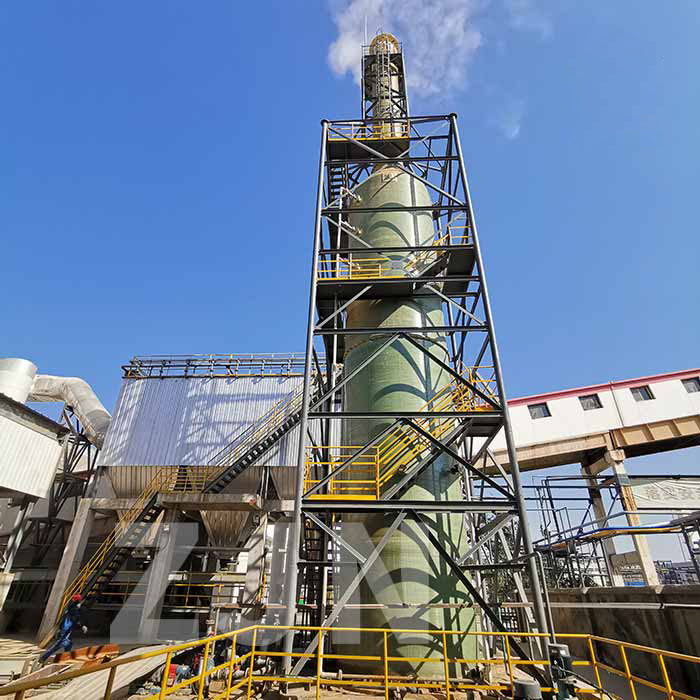
Scrubber
Scrubber systems (e.g. chemical scrubbers, gas scrubbers) are a diverse group of air pollution control devices that can be used to remove some particulates and/or gases from industrial exhaust streams.
The exhaust gases of combustion may contain substances considered harmful to the environment, and the scrubber may remove or neutralize those. A wet scrubber is used for cleaning air, fuel gas or other gases of various pollutants and dust particles. Wet scrubbing works via the contact of target compounds or particulate matter with the scrubbing solution. Solutions may simply be water (for dust) or solutions of reagents that specifically target certain compounds.
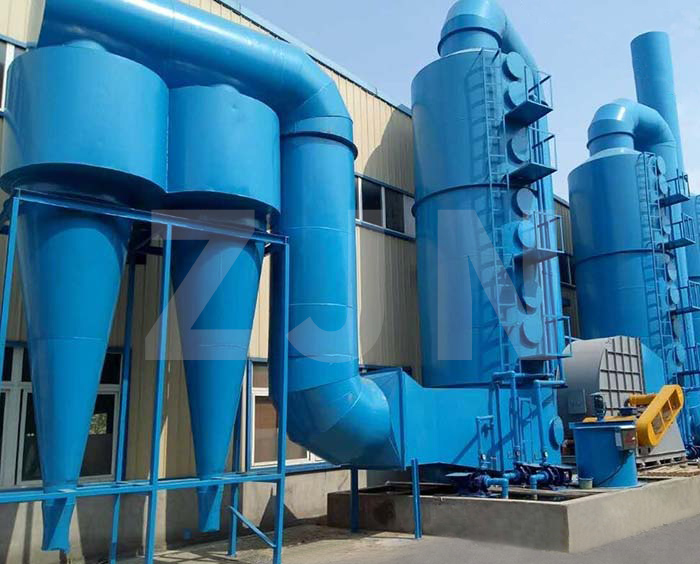
Cyclone Dust Collector
Centrifugal cyclone dust collector, the dust will be separated and recovered in the drying system, through the dry tail gas dust purification device of a cyclone dust collector, suitable for high dust concentration, large dust particles of exhaust gas dust removal operations, the dust collector has a simple structure, stable and reliable operation, long service life, and other characteristics.
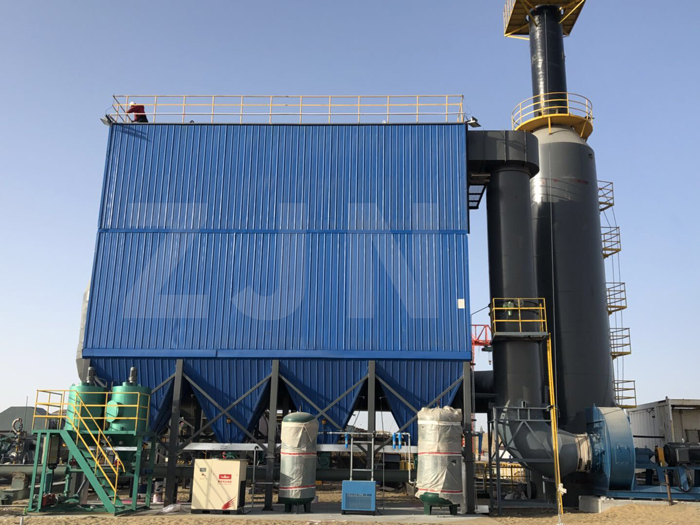
Baghouse
A bag house, also known as a bag house filter, bag filter, or fabric filter is an air pollution control device and dust collector that removes particulates or gas released from commercial processes out of the air.
Most baghouses use long, cylindrical bags (or tubes) made of woven or felted fabric as a filter medium. For applications where there is relatively low dust loading and gas temperatures are 250 °F (121 °C) or less, pleated, non woven cartridges are sometimes used as filtering media instead of bags.
Bag houses are very efficient particulate collectors because of the dust cake formed on the surface of the bags. The fabric provides a surface on which dust collects through the following four mechanisms:
Inertial collection – Dust particles strike the fibers placed perpendicular to the gas-flow direction instead of changing direction with the gas stream.
Interception – Particles that do not cross the fluid streamlines come in contact with fibers because of the fiber size.
Brownian movement – Sub micrometre particles are diffused, increasing the probability of contact between the particles and collecting surfaces.
Electrostatic forces – The presence of an electrostatic charge on the particles and the filter can increase dust capture.
A combination of these mechanisms results in formation of the dust cake on the filter, which eventually increases the resistance to gas flow. The filter must be cleaned periodically.
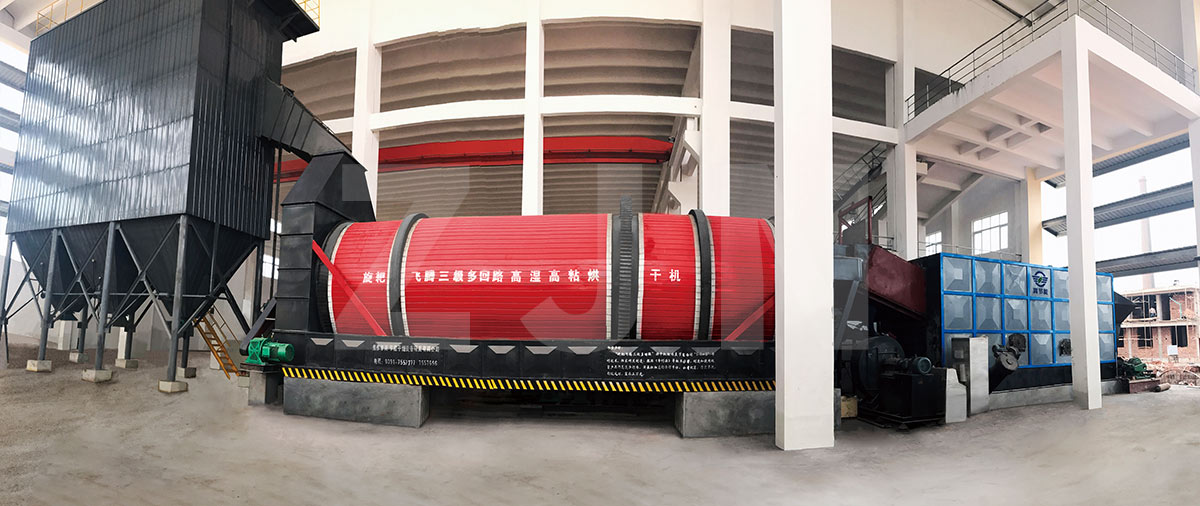
1. Wide range of application: true energy-saving biomass dryer in the original single drum drying equipment on the basis of upgrading and transformation, changed the traditional straight in straight out, single stage drying mode, greatly expanded the scope of application of equipment.
2. Strong production capacity: special cylinder structure, in the limited volume can deal with more materials, greatly increased in the drying process of wet material and hot air contact area, drying speed, strong production capacity, but also to ensure continuous and stable operation.
3. Good drying effect: with the "rotary rake crushing" device set up in the cylinder and the interweaving feeding device, the material forms a uniform screen on the cross section of the cylinder, which not only speeds up the drying speed, but also makes the finished product good color and quality after drying.
4. Good insulation effect, low heat consumption: biomass drying production line adopts a full set of sealed design, and then with a special insulation structure, insulation effect is good, heat loss is small, heat has been fully utilized.
5. Flexible control of equipment parameters: In the drying process, the equipment parameters can be flexibly adjusted according to the fluctuation of material moisture to achieve better drying effect.
6. Simple operation, less failure: biomass dryer equipment covers an area of small, compact structure, low failure rate, long-term stable operation.
Copyright ©2022 by Jiaozuo ZJN Environmental Protection Equipment Technology Co., Ltd.